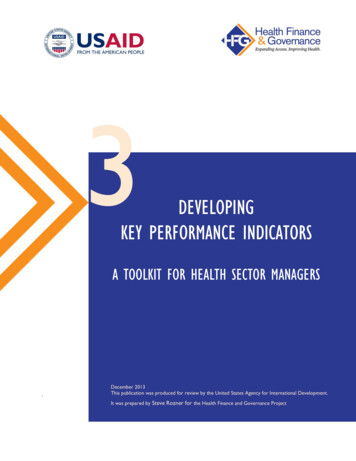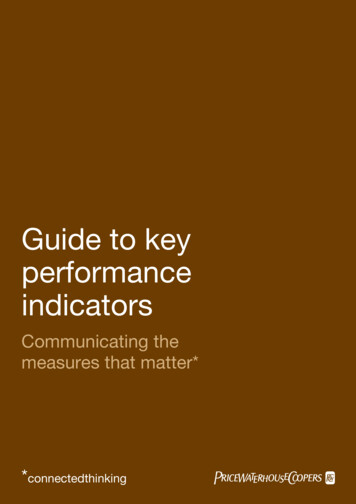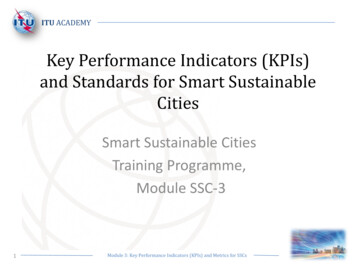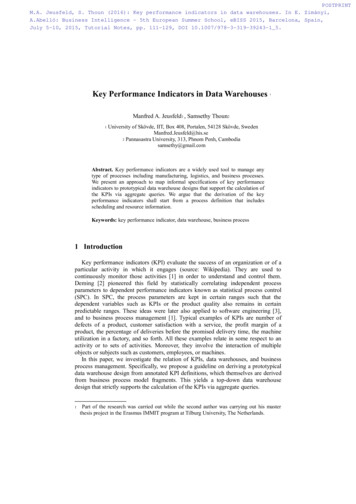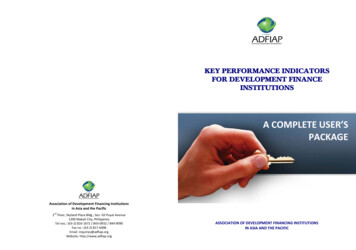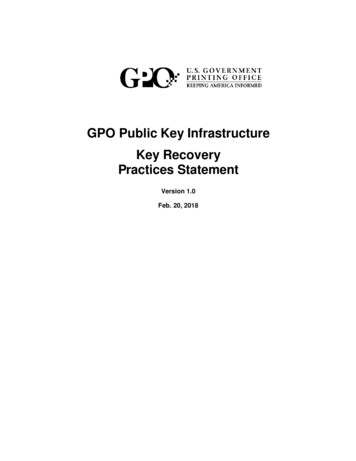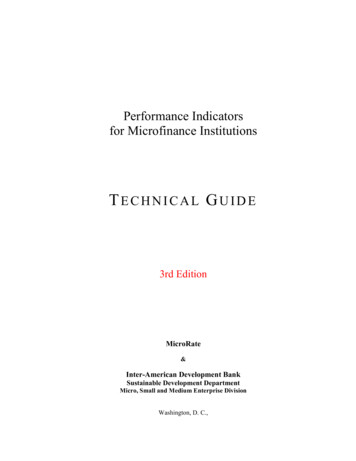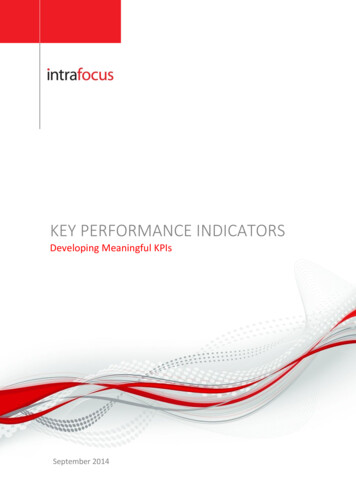
Transcription
KEY PERFORMANCE INDICATORSDeveloping Meaningful KPIsSeptember 2014
Table of ContentsTable of Contents . 1Introduction . 2Successful Strategy Implementation . 2Developing Meaningful KPIs . 2Performance Measures/KPIs . 3What are Performance Measures/KPIs? . 3The Methodology . 4Step 1 – Create Objective . 4Step 2 – Describe Results . 6Step 3 – Identify Measures . 8Step 4 – Define Thresholds . 16Step 5 – Upload Structure/Data into a System . 21Step 6 – Interpret Results . 25Step 7 – Take Action . 34In Conclusion . 38Developing Meaningful KPIsPage 1
IntroductionSuccessful Strategy ImplementationThe success of a strategy is not determined by its definition and documentation. Some ofthe greatest strategies have been defined carefully with great thought and insight. They aremasterpieces that could not be faulted other than being left on the shelf in head-officesaround the world and never implemented. Most companies and organisations are good atdefining strategy; very few are good at successfully implementing strategy.When a strategy has been defined one of the most troublesome tasks an organisation faces(and is often the reason implementation fail) is developing meaningful objectives and theirassociated key performance indicators (KPIs). This task has to be structured. Without a goodmethodology to create Objectives and KPIs, a strategy will never be successfullyimplemented.Developing Meaningful KPIsThe following methodology provides a guide through the process of developing clearobjectives and key performance indicators (KPIs) to support a strategy. It describes theprocesses to ensure that KPIs have targets and owners. It shows how to build KPIs thatprovide evidence that objectives are being met, (or not!)It does not end there though. Once KPIs have been defined, they need to be presented in away that will ensure accurate interpretation. The methodology provides examples of KPIautomation that show how to link interpretation to action thus moving an organisationcloser to its objectives and ultimately its strategy.The methodology has seven steps as follows:This methodology has drawn from decades of in-the-field experience and other publishedmethodologies including Stacy Barr’s PuMP Performance Measure Blueprint and TheBalanced Scorecard Institute’s Nine Steps to Success . Our thanks go to Stacey Barr, WorldRenowned Performance Measure Specialist and Howard Rohm, CEO of the BalancedScorecard Institute for their clarity in describing the subject of Performance Measurement.Developing Meaningful KPIsPage 2
Performance Measures/KPIsWhat are Performance Measures/KPIs?In business, government and non-profit organisations we measure a multitude of things. Wedo this to keep on track, to make improvements and to drive our strategy. Unfortunately,often where we think we have a decent set of key performance indicators, actually we havea hotchpotch of tasks, objectives and projects with a few badly described metrics. So what isa performance measure/KPI?Note: A Key Performance Indicator (KPI) is often referred to as a Performance Measure or aMeasure or a Metric. This is perfectly valid, the important thing is the definition not thelabel, if Metric is term generally used in your organisation, then use it. In a formal BalancedScorecard structure, as defined by the Balanced Scorecard Institute, the term PerformanceMeasure is used. More frequently in business KPI is used. For the purpose of brevity, theterm ‘KPI’ will be used throughout this document.A Key Performance Indicator is something that can be counted and compared; it providesevidence of the degree to which an objective is being attained over a specified time.The definition above includes a set of words that need further explanation to ensure thestatement is fully understood:Counted: This may seem a little trite, however, counted means that a quantity can beassigned. Examples of quantity are number, percentage or currency. It does not mean apercentage achievement. One of the most frequent mistakes in setting KPIs is to create aproject and assess its success through how much work has been done. Just because aproject has completed does not mean it has been a success. Success is dependent on theoutcome not the activity.Compared: A number or value may be interesting but it only becomes useful when it iscompared to what is optimal, acceptable or unacceptable. Every KPI must have acomparator or benchmark. Using an industry benchmark gives an objective quality to thecomparator, objectivity is not required, but it is desirable.Evidence: The evidence will fall out by ‘counting’ and ‘comparing’ correctly. It is importantto strive for a measure that will be observed in the same way by all stakeholders. Theevidence should be clear and have specific meaning.Objective: A KPI only has significance if it is contributing to an objective. If there is noobjective, why is it being measured in the first place? This does not mean we should ignoreall operational measures; they still need to be in place – but even operational measuresshould ultimately contribute to an objective.Specified Time: Everything is time bound; progress towards meeting an objective andtherefore a strategy must be measured over a specified period of time.Developing Meaningful KPIsPage 3
The MethodologyThe design of this methodology for developing meaningful KPIs is based on years ofexperience in this field. The methodology is aimed at companies and organisations thatalready have a defined strategy and a reasonable idea about what their primary objectivesare. The methodology has seven steps and utilises the templates that follow in thisdocument. Steps 5 and 6 are illustrated using an automation system called QuickScore. It isnot the only automation system available in the market. It has been used to provide aninsight into the advantages software automation bring to managing performance data.In any business performance management system, the data added into the system has tohelp drive the business forward. It is tempting to measure far too much and not be specificin the hope the system will ‘sort it out’. The following methodology ensures the rightactivities are pursued.The key is to start small, even as small as a single objective will do. Once practiced increating a few successful objectives and KPIs, then a company-wide challenge can be taken.Steps 1-4 of the methodology is template driven, these steps will be completed severaltimes. The first time through may take a while, thereafter, it becomes much simpler.Steps 5-7 are more descriptive.Step 1 – Create ObjectiveThe Golden Rule: KPIs are based on objectives. A KPI should not exist unless it contributesto an objective. It is true that the thought processes that go into creating KPIs and objectivescan move so quickly that these activities may run in parallel, nevertheless, a KPI should notexist without an objective.Write down an objective that will result in a business improvement:ObjectiveHere are a couple examples that you may have considered: Increase company profit Increase revenue by 10% next yearThese are great objectives and easily measurable and starting at the top is admirable.Developing Meaningful KPIsPage 4
However, think about some objectives that can be more easily controlled to contribute tothese top-line goals, for example: Increase the number of projects worth 250k or more Improve skill level of senior consultants Implement a sales planAs this stage it is not important to be precise, the next stage will crisp up the objectives.Thought should be put into how the objective will contribute to an overall strategy; whetheror not your organisation has any control over the objective (it’s best to have some level ofcontrol); that the objective is a single objective and not several under the guise of a singleobjective and finally it should be something that is important and in need of attention.Go back to the objective you have chosen and check:1. It will contribute to the company/organisation strategy2. It is important and will it make a difference3. It is a single objective4. You have some level of control to influence the result5. It is something that can be measuredIf required, refine the objective, it does not have to be perfect. Move on to step 2.Developing Meaningful KPIsPage 5
Step 2 – Describe ResultsEarlier, in the section that defined a KPI, it was noted that one of the most common mistakesin definition is to focus on activities rather than results. Objectives, like KPIs, are concernedwith results. It is essential to create a result for each objective using a results-orientedlanguage. This forces us to think more precisely about what we are actually trying to achieve.For example, if we look at one of the objectives given above ‘Implement a sales plan’ thismay seem as a very sensible thing to do but it is not a performance objective. It is an activitythat can only be measured through the time it takes to implement the plan. It will tell usnothing about success or failure of the plan relative to the business strategy.[Important note: Activities, initiatives and projects are important. They are the means bywhich we implement change to make improvements. We can measure things until the endof time but that will not change our results. Unless we know where we are today and wherewe want to be tomorrow any change activity will only have a positive impact through purechance. Therefore we need results-oriented objectives]The previous example might be more useful if it included why we want to implement a salesplan. It may be ‘to reduce the sales cycle’. This is still a bit vague and may be betterexpressed as ‘to reduce the time taken to convert a qualified lead into a sale’. This is muchbetter and has produced and objective with a tangible result. This also illustrates the needto bring clarity into the language we use to create our objectives. That is, what are weactually trying to achieve?In business we have a tendency to use words and phrases like ‘best practice, optimised,world class, efficient, effective, productive. Although the implied meaning is positive, theactual meaning is vague. Objectives using these words are not results-oriented and willtherefore always fall short if used when related to performance improvement. It is alwaysbetter to use words that have common meaning and cannot be vaguely interpreted.Using words that relate to how we physically perceive things in the world is a good techniqueto sense-check you are on the right track. Using our previous example; ‘reduce the timetaken to convert a qualified lead into a sale’ if we think about how we would physicallyperceive this, it would almost certainly take us down the route of asking the question; inwhat time-scale do we mean? This in turn would lead to a more succinct expression thatwould include a physical parameter, for example: ‘reduce the number of days to convert aqualified lead into a sale’. We now have an objective that describes a result, has clarity ininterpretation and in this case has a time parameter.At this stage it is not important to go so far as including a target within the objective. Itwould have been easy to express our example as “reduce the number of days to convert aqualified lead to a sale from 30 to 25’. Targets are the domain of the measure rather thanthe objective. When we look at measures in the next step we will look closely at how to settargets in the context of viable comparators or benchmarks.In summary, the step 2 task is to:1. Check that the objective is an objective (not an activity, plan or project)Developing Meaningful KPIsPage 6
2. Frame the objective using result-oriented language3. Remove vague words and include things that can be physically perceivedExamples:Original ObjectiveResult OrientedPhysically PerceivedImplement a sales planReduce the time taken toconvert a qualified lead intoa saleReduce the number of daysto convert a qualified leadinto a saleAll senior consultants to betrained to deliver resultschain analysisImprove skill level of allsenior consultants to deliverresults chain analysisImprove skill level of allsenior consultants to stage 2accreditation in results chainanalysis or aboveIncrease the number ofprojects worth 250k ormoreIncrease the number ofprojects worth 250k ormore*Increase the number ofconsultancy projects worthmore 250k in revenue*Note: Not everything has to be improved or modified. As you get better at this process youwill automatically start creating results-oriented objectives.Enter up to three objectives and go through the process of refining them into resultsoriented objectives that are clearly defined with physical perceived outcomes:Original ObjectiveResult OrientedPhysically PerceivedIf you are happy with these objectives, go to step 3. If this process has revealed you arelooking at the wrong things loop back to step 1.Developing Meaningful KPIsPage 7
Step 3 – Identify MeasuresThere are three key activities that need to occur when identifying a measure:1. The measure needs to be clearly described (and based on an objective)2. The measure needs to be rated in terms of importance3. The measure needs to be calculated and ownership assignedThe measure needs to be clearly described – it does not matter at the moment if lots ofwords are used to describe a KPI. Later on the short ‘label’ will be created for convenience.For now it just needs to have a very clear description and therefore will end up as astatement or short sentence. Start with one of the objectives previously defined.Next, focus on the ‘physically perceived’ part of the objective, this will give you a clue as tothe ‘tangible’ things you need to measure. In the example above “Reduce the number ofdays to convert a qualified lead into a sale” the tangible items are ‘days’ and ‘qualified leads’and ‘sales’. These are the things that can be measured and will be included in the final KPI.At a later point we will include descriptions for each of the ‘tangible’ items.A word of warning: don’t at this point simply go back to what you are measuring already andsay something like ‘got that covered, we already have a lead to sales ratio’. It may be thatyou do have it covered, however, it is more likely that the particular KPI you are thinking ofwas created years ago based on a formula that is no longer relevant. Clearly this will not betrue of all KPIs, but the check needs to be made.It is now time to consider ‘lead’ and ‘lag’ KPIs. All too often our KPIs concentrate on ‘lag’measures. That is, those measures that occur after the event. Typically, financial measuresfall into this category, revenue, gross margin, profit and costs are all things that we measureafter an event has happened. We need to do this as we can learn and adjust, but the act ofmeasurement does not cause change. Why do we concentrate on lag measures? Simplybecause they are easy to count and provide proof of success or failure. If I get on the scalesthey tell me whether or not I have lost or gained weight. If my objective is to lose weight,getting on the scales has not helped. However, if I measure how many times I go for a runand how much I have eaten (and plan for this) then I have put in place two ‘lead’ measuresthat will help me succeed. Lead measures are harder to identify but they are the onlymeasures that can be influenced and therefore make a difference.We must not underestimate the importance of lead measures when identifying anddescribing our KPIs. It may take a little longer to identify these measures but it is worth theeffort in the long run. Even if they are discarded they may provide additional insight into theway an organisation is being run.The final quality of a typical lead measure is that it may not hold a guarantee of success. Inthe following example; ‘The number of sales people trained in selling our products to grade IIIcertification’ we believe that this will have a positive impact on our objective, becausecommon sense dictates that trained people will perform better than untrained people, butwe will only have the proof when we see a positive change in the lag other measures.Developing Meaningful KPIsPage 8
The tangible parts of the objective need to be written into a KPI that describes somethingthat can actually be counted and relates back to the objective. For example:ObjectiveKPI – DescriptionReduce the number ofdays to convert aqualified lead into asaleThe average number of days between a qualified lead and a saleorThe average number of days between qualified leads and salesthat result in an order value greater than 250korThe percentage of sales generated within 30 days of leadqualificationorThe number of sales people trained in selling our products to gradeIII certification (note this is a ‘lead’ measure)As can be seen from the above, each KPI is relevant to the objective but is measuring it in aslightly different way. Also, we can see that the measure type has been added, in the casesabove ‘average’ and ‘percentage’. Furthermore we can see that a calculation is beginning toform, the KPI calculation is a very important part of the identification as it provides thescientific/objective basis for its accuracy.For now, let’s concentrate on the description, the key things to remember are; Write the description in the form of a sentence Include the ‘tangible’ words, the things that can be counted Don’t immediately think you have ‘got it covered’ Think in terms of a calculation that will be performedWrite down an objective and two or three candidate KPIs:ObjectiveKPI – DescriptionororDeveloping Meaningful KPIsPage 9
or (for the last one, try to think of a ‘lead’ measure)The measure needs to be rated in terms of importance – Time and effort should be put intorating KPIs. It is important to ensure the right things are measured. A relatively simpleprocess can be used to build a decision matrix, start with the following: How applicable the measure is to a related business objective The relative worth of each measure, do you really need to know The ease by which data can be found to make the measurementFor each KPI ask the three questions above (in order, more later) and rate them HighMedium or Low. As a guide the use the following:For Applicability: High – This measure will give me enough information to determine whether or notwe are achieving this business objective Medium – This measure will give me enough information to make an informeddecision as to whet
associated key performance indicators (KPIs). This task has to be structured. Without a good methodology to create Objectives and KPIs, a strategy will never be successfully implemented. Developing Meaningful KPIs The following methodology provides a



